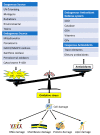Research Progress on Oxidative Stress and Its Nutritional Regulation Strategies in Pigs
- PMID: 34068057
- PMCID: PMC8152462
- DOI: 10.3390/ani11051384
Research Progress on Oxidative Stress and Its Nutritional Regulation Strategies in Pigs
Abstract
Oxidative stress refers to the dramatic increase in the production of free radicals in human and animal bodies or the decrease in the ability to scavenging free radicals, thus breaking the antioxidation-oxidation balance. Various factors can induce oxidative stress in pig production. Oxidative stress has an important effect on pig performance and healthy growth, and has become one of the important factors restricting pig production. Based on the overview of the generation of oxidative stress, its effects on pigs, and signal transduction pathways, this paper discussed the nutritional measures to alleviate oxidative stress in pigs, in order to provide ideas for the nutritional research of anti-oxidative stress in pigs.
Keywords: nutritional additive modulation; oxidative stress; performance; pigs; signaling pathways.
Conflict of interest statement
The authors declare no conflict of interest.
Figures




Similar articles
-
Effects of high- and low-fiber diets on intestinal oxidative stress in growing-finishing pigs.J Anim Sci. 2022 Nov 1;100(11):skac306. doi: 10.1093/jas/skac306. J Anim Sci. 2022. PMID: 36104002 Free PMC article.
-
Soy protein concentrate replacing animal protein supplements and its impacts on intestinal immune status, intestinal oxidative stress status, nutrient digestibility, mucosa-associated microbiota, and growth performance of nursery pigs.J Anim Sci. 2022 Oct 1;100(10):skac255. doi: 10.1093/jas/skac255. J Anim Sci. 2022. PMID: 35950990 Free PMC article.
-
The relevant targets of anti-oxidative stress: a review.J Drug Target. 2021 Aug;29(7):677-686. doi: 10.1080/1061186X.2020.1870987. Epub 2021 Jan 12. J Drug Target. 2021. PMID: 33401976 Review.
-
Nutritional strategies to alleviate oxidative stress in sows.Anim Nutr. 2021 Nov 3;9:60-73. doi: 10.1016/j.aninu.2021.10.006. eCollection 2022 Jun. Anim Nutr. 2021. PMID: 35949982 Free PMC article. Review.
-
Impact of dietary oxidized protein on oxidative status and performance in growing pigs.J Anim Sci. 2020 May 1;98(5):skaa097. doi: 10.1093/jas/skaa097. J Anim Sci. 2020. PMID: 32219327 Free PMC article.
Cited by
-
Plant-derived squalene supplementation improves growth performance and alleviates acute oxidative stress-induced growth retardation and intestinal damage in piglets.Anim Nutr. 2023 Sep 30;15:386-398. doi: 10.1016/j.aninu.2023.09.001. eCollection 2023 Dec. Anim Nutr. 2023. PMID: 38058564 Free PMC article.
-
Differentially Expressed Hepatic Genes Revealed by Transcriptomics in Pigs with Different Liver Lipid Contents.Oxid Med Cell Longev. 2022 Jan 28;2022:2315575. doi: 10.1155/2022/2315575. eCollection 2022. Oxid Med Cell Longev. 2022. PMID: 35132345 Free PMC article.
-
Cutting-edge knowledge on the roles of phytobiotics and their proposed modes of action in swine.Front Vet Sci. 2023 Sep 20;10:1265689. doi: 10.3389/fvets.2023.1265689. eCollection 2023. Front Vet Sci. 2023. PMID: 37808106 Free PMC article. Review.
-
Oxidative Stress and Intestinal Transcriptome Changes in Clostridium perfringens Type A-Caused Enteritis in Deer.Genes (Basel). 2025 Aug 11;16(8):949. doi: 10.3390/genes16080949. Genes (Basel). 2025. PMID: 40869997 Free PMC article.
-
Effects of Lactic Acid and Glyceryl Lactate on Growth Performance, Antioxidant Capacity, and Intestinal Health of Piglets.Antioxidants (Basel). 2025 Mar 26;14(4):391. doi: 10.3390/antiox14040391. Antioxidants (Basel). 2025. PMID: 40298648 Free PMC article.
References
-
- Sies H. Oxidative Stress. Academic Press; Cambridge, MA, USA: 1985. Oxidative Stress: Introductory Remarks; pp. 1–5.
Publication types
Grants and funding
LinkOut - more resources
Full Text Sources

